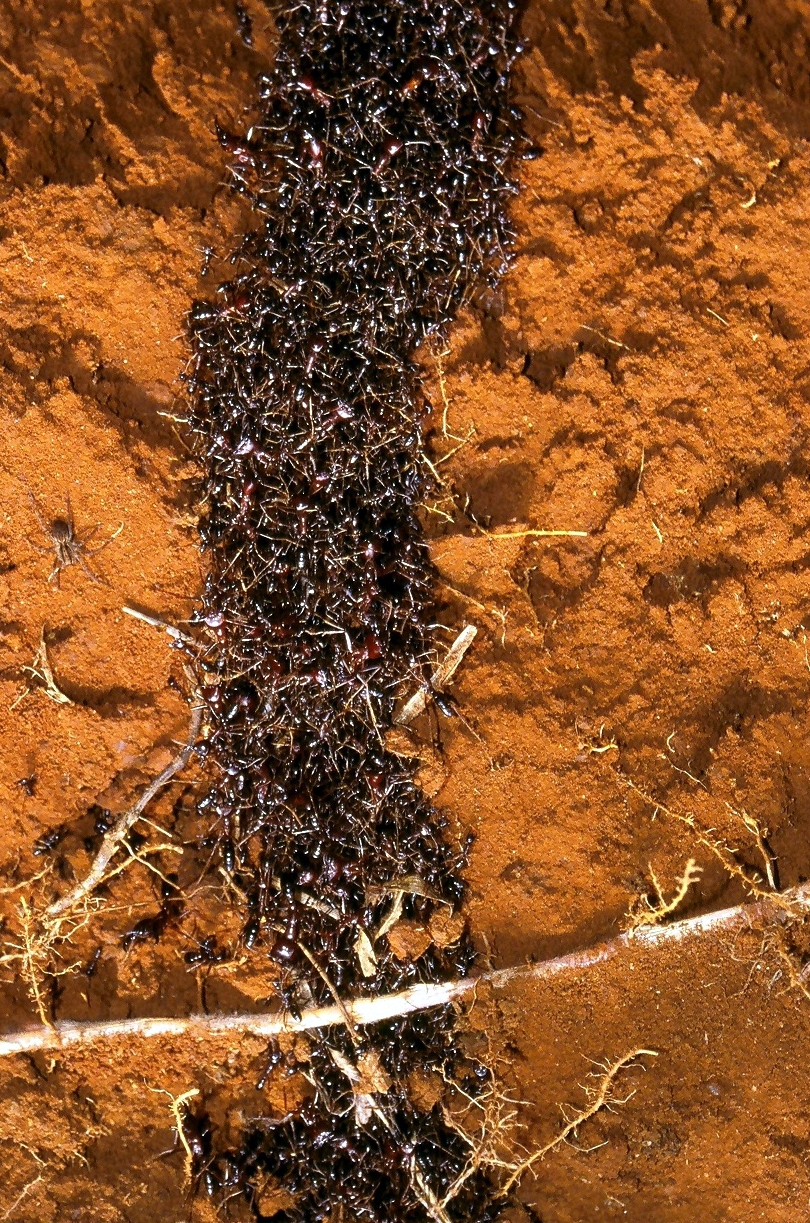|
Ant Mill
An ant mill is an observed phenomenon in which a group of army ants, separated from the main foraging party, lose the pheromone track and begin to follow one another, forming a continuously rotating circle. This circle is commonly known as a "death spiral" because the ants might eventually die of exhaustion. It has been reproduced in laboratories and in ant colony simulations. The phenomenon is a side effect of the self-organizing structure of ant colonies. Each ant merely follows the ant in front of it, which functions until a slight deviation begins to occur, typically by an environmental trigger, and an ant mill forms. An ant mill was first described in 1921 by William Beebe, who observed a mill 370 m in circumference. It took each ant two and a half hours to make one revolution. Similar phenomena have been noted in processionary caterpillars and fish. See also * * * * * * References External links YouTube video of an ant mill Myrmecology Mill Mill may ... [...More Info...] [...Related Items...] OR: [Wikipedia] [Google] [Baidu] |
Army Ants
The name army ant (or legionary ant or ''marabunta'') is applied to over 200 ant species in different lineages. Because of their aggressive predatory foraging groups, known as "raids", a huge number of ants forage simultaneously over a limited area. Another shared feature is that, unlike most ant species, army ants do not construct permanent nests; an army ant colony moves almost incessantly over the time it exists. All species are members of the true ant family, Formicidae, but several groups have independently evolved the same basic behavioural and ecological syndrome. This syndrome is often referred to as "legionary behaviour", and may be an example of convergent evolution. Most New World army ants belong to the genera '' Cheliomyrmex'', ''Neivamyrmex'', '' Nomamyrmex'', '' Labidus'', and '' Eciton''. The largest genus is ''Neivamyrmex'', which contains more than 120 species; the most predominant species is '' Eciton burchellii''; its common name "army ant" is considered t ... [...More Info...] [...Related Items...] OR: [Wikipedia] [Google] [Baidu] |
Pheromone
A pheromone () is a secreted or excreted chemical factor that triggers a social response in members of the same species. Pheromones are chemicals capable of acting like hormones outside the body of the secreting individual, to affect the behavior of the receiving individuals. There are ''alarm signal, alarm pheromones'', ''food trail pheromones'', ''sex pheromones'', and many others that affect behavior or physiology. Pheromones are used by many organisms, from basic unicellular prokaryotes to complex multicellular eukaryotes. Their use among insects has been particularly well documented. In addition, some vertebrates, plants and ciliates communicate by using pheromones. The ecological functions and evolution of pheromones are a major topic of research in the field of chemical ecology. Background The portmanteau word "pheromone" was coined by Peter Karlson and Martin Lüscher in 1959, based on the Greek language, Greek () and (). Pheromones are also sometimes classified as ec ... [...More Info...] [...Related Items...] OR: [Wikipedia] [Google] [Baidu] |
Fatigue (medical)
Fatigue is a state of tiredness (which is not sleepiness), exhaustion or loss of energy. It is a symptom of any of various diseases; it is not a disease in itself. Fatigue (in the medical sense) is sometimes associated with medical conditions including autoimmune disease, organ failure, chronic pain conditions, mood disorders, heart disease, infectious diseases, and post-infectious-disease states. However, fatigue is complex and in up to a third of primary care cases no medical or psychiatric diagnosis is found. Fatigue (in the general usage sense of normal tiredness) often follows prolonged physical or mental activity. Physical fatigue results from muscle fatigue brought about by intense physical activity. Mental fatigue results from prolonged periods of cognitive activity which impairs cognitive ability, can manifest as sleepiness, lethargy, or directed attention fatigue, and can also impair physical performance. Definition Fatigue in a medical context is used to ... [...More Info...] [...Related Items...] OR: [Wikipedia] [Google] [Baidu] |
Self-organizing
Self-organization, also called spontaneous order in the social sciences, is a process where some form of overall order and disorder, order arises from local interactions between parts of an initially disordered system. The process can be spontaneous when sufficient energy is available, not needing control by any external agent. It is often triggered by seemingly random Statistical fluctuations, fluctuations, amplified by positive feedback. The resulting organization is wholly decentralized, :wikt:distribute, distributed over all the components of the system. As such, the organization is typically Robustness, robust and able to survive or self-healing material, self-repair substantial perturbation theory, perturbation. Chaos theory discusses self-organization in terms of islands of predictability in a sea of chaotic unpredictability. Self-organization occurs in many physics, physical, chemistry, chemical, biology, biological, robotics, robotic, and cognitive systems. Examples of ... [...More Info...] [...Related Items...] OR: [Wikipedia] [Google] [Baidu] |
Ant Colony
An ant colony is a population of ants, typically from a single species, capable of maintaining their complete lifecycle. Ant colonies are eusocial, communal, and efficiently organized and are very much like those found in other social Hymenoptera, though the various groups of these developed sociality independently through convergent evolution. The typical colony consists of one or more egg-laying queens, numerous sterile females (workers, soldiers) and, seasonally, many winged sexual males and females. In order to establish new colonies, ants undertake flights that occur at species-characteristic times of the day. Swarms of the winged sexuals (known as alates) depart the nest in search of other nests. The males die shortly thereafter, along with most of the females. A small percentage of the females survive to initiate new nests. Etymology The term "ant colony" refers to a population of workers, reproductive individuals, and brood that live together, cooperate, and treat ... [...More Info...] [...Related Items...] OR: [Wikipedia] [Google] [Baidu] |
William Beebe
Charles William Beebe ( ; July 29, 1877 – June 4, 1962) was an American natural history, naturalist, ornithologist, marine biologist, entomologist, explorer, and author. He is remembered for the numerous expeditions he conducted for the New York Zoological Society, such as the Arcturus expedition, ''Arcturus'' mission, his deep dives in the Bathysphere, and his prolific scientific writing for academic and popular audiences. Born in Brooklyn, New York, Brooklyn, New York (state), New York and raised in East Orange, New Jersey, Beebe left college before obtaining a degree to work at the then newly opened Bronx Zoo, New York Zoological Park, where he was given the duty of caring for the zoo's birds. He quickly distinguished himself in his work for the zoo, first with his skill in designing habitats for its bird population, and soon also with a series of research expeditions of increasing length, including an expedition around the world to document the world's pheasants. These exp ... [...More Info...] [...Related Items...] OR: [Wikipedia] [Google] [Baidu] |
Thaumetopoeidae
Thaumetopoeinae is a subfamily of moths in the family Notodontidae. This group is sometimes treated as a family Thaumetopoeidae with three subfamilies: Thaumetopoeinae, Anaphinae and Epicominae. However, it is now commonly treated at subfamily rank based on morphological and molecular phylogenetic evidence. The etymology of the subfamily name derives from the Ancient Greek words (, 'marvelous') and (, 'to do') and literally means ''showing beautiful things''. This explains why the name is sometimes spelled ''Thaumatopoeinae'', incorrectly from the taxonomic standpoint, but in accordance with etymology. The larval stage of some Thaumetopoeinae are known as processionary caterpillars, so named because they move in columns in search of food, resembling a procession. Some of the species, like the pine and oak processionaries, can constitute a health hazard due to their urticating hairs. Genera and some species *'' Aglaosoma'' **'' Aglaosoma variegata'' *'' Axiocleta'' *'' Cynos ... [...More Info...] [...Related Items...] OR: [Wikipedia] [Google] [Baidu] |
Myrmecology
Myrmecology (; from Greek: μύρμηξ, ''myrmex'', "ant" and λόγος, ''logos'', "study") is a branch of entomology focusing on the study of ants. Ants continue to be a model of choice for the study of questions on the evolution of social systems because of their complex and varied forms of social organization. Their diversity and prominence in ecosystems also has made them important components in the study of biodiversity and conservation. In the 2000s, ant colonies began to be studied and modeled for their relevance in machine learning, complex interactive networks, stochasticity of encounter and interaction networks, parallel computing, and other computing fields. History The word myrmecology was coined by William Morton Wheeler (1865–1937), although human interest in the life of ants goes back to ancient times. The earliest scientific thinking based on observation of ant life was that of Auguste Forel (1848–1931), a Swiss psychologist who initially was interest ... [...More Info...] [...Related Items...] OR: [Wikipedia] [Google] [Baidu] |
Ants
Ants are eusocial insects of the family Formicidae and, along with the related wasps and bees, belong to the order Hymenoptera. Ants evolved from vespoid wasp ancestors in the Cretaceous period. More than 13,800 of an estimated total of 22,000 species have been classified. They are easily identified by their geniculate (elbowed) antennae and the distinctive node-like structure that forms their slender waists. Ants form colonies that range in size from a few dozen individuals often living in small natural cavities to highly organised colonies that may occupy large territories with sizeable nest that consist of millions of individuals or into the hundreds of millions in super colonies. Typical colonies consist of various castes of sterile, wingless females, most of which are workers (ergates), as well as soldiers (dinergates) and other specialised groups. Nearly all ant colonies also have some fertile males called "drones" and one or more fertile females called "queens ... [...More Info...] [...Related Items...] OR: [Wikipedia] [Google] [Baidu] |





